Age spots are a common concern for many individuals as they navigate the journey of aging while striving to maintain healthy and radiant skin. In this article, we will explore the world of age spots, shedding light on their causes, characteristics, and potential treatment options, all accompanied by age spots pictures for visual reference.
Understanding age spots is crucial in the realm of skincare, as it empowers us to make informed choices and take proactive steps in preserving the youthful glow of our skin. So, let’s embark on this enlightening journey to uncover the secrets of age spots and discover effective ways to manage them.
What Are Age Spots?

Age spots, often referred to as liver spots, sunspots, or solar lentigines, are common blemishes that appear on the skin as people get older. These flat, brown or grayish spots typically develop on areas of the skin that are frequently exposed to the sun, such as the face, hands, shoulders, and arms.
These spots are characterized by their small, oval or round shape and can vary in size. While age spots are generally harmless and painless, they can be a cosmetic concern for many individuals.
Age spots are primarily caused by prolonged and repeated exposure to the sun’s harmful ultraviolet (UV) rays. Over time, this exposure can lead to the accumulation of melanin, the pigment responsible for the color of our skin, hair, and eyes. As melanin production increases in response to UV exposure, it can clump together in certain areas, resulting in the formation of these distinct spots.
Causes of Age Spots
Understanding the causes of age spots is essential for taking preventive measures and maintaining healthy, youthful-looking skin. These skin blemishes primarily develop due to prolonged and repeated exposure to the sun’s harmful ultraviolet (UV) rays. Let’s explore this key factor in more detail:
Sun Exposure
Sun exposure plays a central role in the formation of age spots. When our skin is exposed to sunlight, especially UVB and UVA rays, it triggers the production of melanin. Melanin is the pigment responsible for giving our skin its color, and it acts as a natural defense mechanism against the harmful effects of UV radiation.
However, over time, excessive sun exposure can lead to an uneven distribution of melanin. Instead of spreading evenly, melanin may clump together in certain areas of the skin. This clumping results in the formation of age spots, which are typically more prevalent in areas frequently exposed to the sun, such as the face, hands, shoulders, and arms.
Light Skin and Age Spots
Individuals with light skin are more prone to developing age spots. Light skin has less melanin than darker skin, making it more susceptible to UV damage. As a result, people with fair skin, pale complexions, or a lighter complexion are at an increased risk of developing age spots.
While sun exposure is the primary cause of age spots, it’s important to note that other factors, such as genetics and aging itself, can also contribute to their development. Genetics can play a role in determining an individual’s susceptibility to age spots, while the natural aging process can lead to changes in the skin that make age spots more noticeable.
You may be interested to read about freeze away skin tag remover
How Melanin Affects Age Spots
Melanin, the pigment responsible for our skin’s color and protection, plays a significant role in the development of age spots. Understanding how melanin affects age spots is essential for grasping the science behind these skin blemishes and their appearance on the surface.
The Role of Melanin
Melanin, a natural pigment found in the epidermis, the outermost layer of the skin, plays a vital role in skin protection. Its primary function is to absorb and dissipate the energy from UV radiation, thereby protecting the skin from the harmful effects of the sun. When exposed to UV rays, our skin responds by producing more melanin as a defense mechanism.
However, as we age and accumulate sun exposure over the years, this melanin production can become uneven. Instead of being evenly distributed throughout the skin, melanin may begin to cluster in specific areas, leading to the formation of age spots. These age spots appear as dark, flat, and typically oval or round patches on the skin.
Factors Contributing to Uneven Melanin Distribution
Age spots are more likely to occur in areas that receive the most sun exposure. This is because prolonged exposure to UV radiation can stimulate the production of melanin, but it can also disrupt its distribution. Factors contributing to uneven melanin distribution include:
- Chronic Sun Exposure: Continuous exposure to sunlight over years or decades can lead to an accumulation of melanin in certain areas.
- UV Radiation: UV radiation from the sun can penetrate the skin, causing damage to melanocytes, the cells responsible for producing melanin.
- Aging: The natural aging process can affect the skin’s ability to evenly distribute melanin, making age spots more noticeable as we get older.
Pigmentation and Age Spots
Age spots are essentially areas of concentrated pigmentation due to the uneven distribution of melanin. This pigmentation can result in the appearance of brown or grayish patches on the skin’s surface. While age spots are generally harmless and not a cause for medical concern, many people seek ways to manage or reduce their visibility for cosmetic reasons.
In the sections that follow, we’ll explore the impact of sun exposure (mention LSI keyword “sun exposure”) on melanin
The Impact of Sun Exposure
Sun exposure is a primary factor contributing to the development of age spots. Understanding the effects of sun exposure on the skin is crucial for taking proactive steps to protect yourself from these blemishes and maintain healthy, radiant skin.
The Role of Ultraviolet (UV) Rays
The sun emits various types of ultraviolet (UV) rays, including UVB and UVA rays, both of which can have detrimental effects on the skin. Here’s how they impact the skin:
- UVB Rays: These rays primarily affect the outermost layer of the skin, the epidermis. UVB rays are responsible for causing sunburn and can contribute to the development of age spots.
- UVA Rays: UVA rays penetrate deeper into the skin, affecting the dermis. They can lead to premature aging, including the formation of age spots.
Accumulated Sun Damage
Prolonged and cumulative exposure to UV radiation from the sun can result in several skin-related issues, including:
- Uneven Melanin Production: As mentioned earlier, sun exposure stimulates the production of melanin. However, excessive exposure can lead to an uneven distribution of melanin, causing age spots to form.
- Wrinkles and Fine Lines: UV radiation can break down collagen and elastin fibers in the skin, leading to the formation of wrinkles and fine lines.
- Sunburn: Acute overexposure to the sun’s UVB rays can cause painful sunburn, which, over time, can contribute to skin damage and the development of age spots.
Importance of Sunscreen
One of the most effective ways to protect your skin from age spots and other sun-related issues is by using sunscreen. Sunscreen, also referred to as sunblock, contains ingredients that help block or absorb UV radiation, preventing it from penetrating the skin.
SPF (Sun Protection Factor) is a measurement used to indicate the level of protection a sunscreen offers. Higher SPF values provide greater protection against UVB rays, which are particularly associated with age spot formation. It’s essential to apply sunscreen generously to all exposed skin areas, including the face, hands, and neck, and to reapply it regularly, especially when spending time outdoors.
Age Spots vs. Skin Cancer
Distinguishing between age spots and skin cancer is essential for maintaining good skin health and addressing any concerns you may have about skin blemishes. In this section, we’ll explore the key differences between age spots and skin cancer, providing valuable insights to help you identify and manage these conditions effectively.
Age Spots: Benign Pigmentation
Age spots, also known as liver spots or solar lentigines, are typically harmless, benign pigmented areas that appear on the skin’s surface. They are characterized by their flat, brown or grayish color and tend to develop in areas frequently exposed to the sun, such as the face, hands, shoulders, and arms.
Key Characteristics of Age Spots:
- Small, flat, and round or oval in shape.
- Uniform in color, often brown or gray.
- Typically painless and do not change in size or shape rapidly.
Skin Cancer: Malignant Growth
Skin cancer, on the other hand, is a potentially serious medical condition characterized by the uncontrolled growth of abnormal skin cells. Unlike age spots, skin cancer can be life-threatening if left untreated.
You may want to read about varicose veins cancer symptoms
Key Characteristics of Skin Cancer:
- Irregularly shaped moles or lesions.
- Changes in size, shape, or color over time.
- May be accompanied by symptoms such as itching, bleeding, or pain.
- Can spread to other parts of the body if not addressed promptly.
Seeking Medical Evaluation
If you have concerns about any skin blemishes, it’s essential to consult a healthcare provider or dermatologist for a thorough evaluation. They can determine whether a skin lesion is benign, such as an age spot, or if it requires further investigation and potential treatment.
Regular skin check-ups with a healthcare professional are particularly important if you have a history of extensive sun exposure, a family history of skin cancer, or if you notice any changes in your skin’s appearance. Early detection and treatment of skin cancer significantly improve outcomes.
Age Spots Treatment Options
When it comes to managing age spots, there are various treatment options available to help reduce their visibility and restore a more even skin tone. In this section, we’ll explore these treatment methods, keeping in mind that age spots are generally harmless but may be a cosmetic concern for some individuals.
We have also written an article about darkening your skin without sun exposure
Over-the-Counter Products
Over-the-counter (OTC) products are readily available and can be an accessible option for those looking to address age spots at home. These products often contain active ingredients like hydroquinone, glycolic acid, or kojic acid, which can help fade age spots over time.
Key Points:
- OTC products require consistent use over several weeks or months to see results.
- Follow product instructions carefully to avoid adverse reactions.
- Some individuals may experience skin irritation, so it’s essential to conduct a patch test before applying to larger areas.
Dermatological Procedures
Dermatologists offer a range of professional procedures to address age spots more effectively. These procedures are typically faster and may provide more noticeable results compared to OTC products.
Common Dermatological Procedures for Age Spots:
- Laser Therapy: Laser treatments use focused beams of light to target and break down pigmented areas, allowing new, evenly pigmented skin to replace them.
- Chemical Peels: Chemical peels involve the application of a chemical solution to the skin, causing it to peel and reveal new, unblemished skin underneath.
- Cryotherapy: This procedure involves freezing the age spots using liquid nitrogen, causing them to peel off.
- Microdermabrasion: Microdermabrasion uses a machine to exfoliate the outer layer of the skin, improving its texture and appearance.
Medical Intervention
For individuals with particularly stubborn age spots or those who desire more aggressive treatment, medical intervention options are available. These may include prescription-strength topical creams or even surgical removal.
Key Points:
- Medical intervention should be discussed with a healthcare provider or dermatologist to determine the most suitable approach.
Prevention is Key
While treating age spots is an option, prevention is often the best strategy. Protecting your skin from excessive sun exposure is crucial in preventing age spots from developing or worsening.
- Use Sunscreen: Apply a broad-spectrum sunscreen with a high SPF daily, even on cloudy days (mention LSI keyword “sunscreen”).
- Protective Clothing: Wear protective clothing, such as wide-brimmed hats and long-sleeved shirts, when outdoors.
- Seek Shade: Avoid direct sun exposure during peak hours when the sun’s rays are strongest.
Prevention and Skincare Tips
Preventing age spots and maintaining healthy, youthful-looking skin is achievable through a combination of preventive measures and a consistent skincare routine. In this section, we’ll explore essential tips to help you safeguard your skin from age spots and promote overall skin health.
You may be interested to read about zo skin health
Sun Protection is Paramount
- Use Sunscreen Regularly: Apply a broad-spectrum sunscreen with a minimum SPF of 30 to all exposed skin areas, including your face, neck, hands, and arms. Reapply every two hours, especially when outdoors (mention LSI keyword “sunscreen”).
- Seek Shade: Whenever possible, stay in the shade, especially during peak sun hours between 10 a.m. and 4 p.m.
- Protective Clothing: Wear protective clothing like wide-brimmed hats, sunglasses, and long-sleeved shirts to shield your skin from UV rays.
- UV Protection: Invest in sunglasses with UV protection to safeguard your eyes from harmful sun exposure.
Maintain a Consistent Skincare Routine
- Cleansing: Cleanse your face gently twice daily to remove dirt and impurities.
- Moisturizing: Use a moisturizer suitable for your skin type to keep your skin hydrated.
- Exfoliation: Exfoliate your skin regularly to remove dead skin cells and promote skin renewal.
- Topical Antioxidants: Consider using skincare products with antioxidants like vitamin C, which can help protect your skin from environmental damage.
Stay Hydrated and Eat a Balanced Diet
- Hydration: Drink plenty of water to keep your skin hydrated from within. Proper hydration can contribute to a healthy complexion.
- Diet: Consume a balanced diet rich in fruits, vegetables, and foods high in antioxidants. Antioxidants can help combat free radical damage and support skin health.
Regular Skin Check-Ups
- Dermatologist Visits: Schedule regular skin check-ups with a dermatologist, especially if you have a history of sun exposure or notice any changes in your skin (mention LSI keyword “doctor”).
- Self-Examination: Perform self-examinations to monitor your skin for any changes, new moles, or irregularities. If you notice anything unusual, seek professional evaluation promptly.
By incorporating these preventive measures and skincare tips into your daily routine, you can significantly reduce the risk of age spots and maintain vibrant, healthy skin. Remember that protecting your skin from the sun’s harmful UV rays is key to preserving its youthful appearance for years to come.
Conclusion
In our journey to understand age spots, we’ve explored their causes, the role of melanin, the impact of sun exposure, and how to differentiate age spots from more serious skin conditions. We’ve also delved into various treatment options and essential prevention strategies to help you achieve and maintain healthy, youthful-looking skin.
As we conclude this exploration, it’s important to emphasize that while age spots are generally harmless and a natural part of the aging process, they can be a cosmetic concern for some individuals. Whether you choose to address age spots or embrace them as part of your skin’s unique history, the key lies in taking care of your skin’s health.
By following the preventive measures and skincare tips outlined in this article, you can proactively protect your skin from excessive sun damage, maintain hydration, and promote overall skin health. Regular skin check-ups with a dermatologist ensure early detection of any skin irregularities, allowing for prompt medical intervention if necessary.
Remember that age spots do not define your skin’s beauty, and everyone’s skin journey is unique. Embrace your skin’s natural changes, take good care of it, and enjoy the confidence that comes with radiant and healthy skin at any age.


